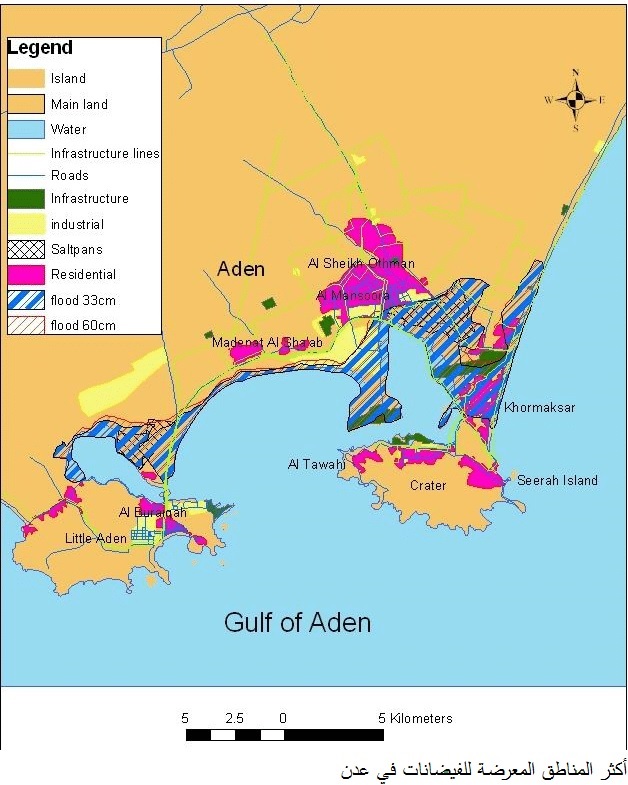A climate war is worsening in ignorance.. Aden is the sixth most vulnerable city in the world to floods
English - Tuesday 26 September 2023 الساعة 10:01 am Newsyemen, special translation:
Newsyemen, special translation:
At a time when warnings continue of the recurrence of devastating floods in Yemen, especially the city of Aden, similar to the floods in the Libyan city of Derna, a recent study reported that Aden is ranked sixth among the cities most vulnerable to sea level rise and storm surge in the world.
The study, prepared by the research unit of the Yemeni Family Welfare Society entitled “The Effects of Climate Change on Yemen and Adaptation Strategies,” revealed that Yemen ranks 171 out of 181 countries in the climate change vulnerability index, according to 2022 data. The country is also considered number 22 among The most vulnerable countries and ranked 12th among the countries least prepared to confront climate change.
The association said in its export of the study that it completed in English last July and published on the website of the United Nations Office for the Coordination of Humanitarian Affairs last Saturday, that the aim of the study “is to shed light on climate-related risks and their effects on various sectors such as water, agriculture, coastal areas, livelihoods and food security, and their effects on Vulnerable groups such as women, girls, children, persons with disabilities, and the elderly.” The study also highlights “climate-related conflicts, and mitigation and adaptation solutions that can be implemented to mitigate the effects of climate change on the country.”
Despite being one of the countries contributing the least to greenhouse gas emissions, Yemen is highly vulnerable to climate change-related impacts such as drought, severe floods, pests, sudden disease outbreaks, changes in rainfall patterns, increased frequency/intensity of storms and sea level rise, threatening the already fragile situation of the country.
The study indicated that the exposure of Yemen, especially the city of Aden and the coastal areas, to hurricanes and floods has worsened in recent years as a result of climate change and global warming, pointing out that rainfall in Yemen is accompanied by seasonal, short-term severe storms that often lead to sudden floods with consequent consequences. From landslides, soil erosion, uprooting of plants, and deterioration of agricultural terraces. At times, these floods caused significant economic damage and loss of crops and lives.
According to the study, Yemen is one of the five low-income countries most vulnerable to sea level rise, and it is expected that sea level will rise by 0.3 to 0.54 meters by 2100. It stated that sea level rise will also lead to salt water intrusion, making layers Coastal groundwater is undrinkable.
The study included statistical figures on the effects of climate change in Yemen on resources, agriculture, food security, coastal areas, health, and vulnerable communities. For example, climate change affects the recharge of groundwater aquifers due to changes in rainfall in terms of quantity and distribution, which has made Yemen the seventh most water-scarce country in the world with a decline in groundwater levels ranging from 3 to 8 meters annually in critical basins.

The agricultural sector in Yemen was affected by floods, drought, and pests, which contributed to a decline in crop productivity. Desertification caused by drought has led to an annual loss of between 3 and 5% of arable land. Depletion of water resources may reduce agricultural productivity by 40%. Floods also led to soil erosion and loss of agricultural land, reducing agricultural land from 1.6 million hectares in 2010 to 1.2 million hectares in 2020. The impact of climate change on Yemeni agriculture is expected to worsen in the future, especially with more intense rainfall And longer dryness
Regarding food security, the study indicated that currently, it is estimated that about 19 million Yemenis (about 62% of the population) face food insecurity, and 161,000 people live in famine-like conditions. In the 2022 Global Hunger Index, Yemen ranks 121 out of 121 countries.
Regarding the health sector, many endemic and epidemic diseases in Yemen are affected by climate events. The spread of cholera is affected by heavy rains and drought events, and drought and floods are associated with an increased risk of malnutrition, vector-borne diseases, and water-borne diseases. Extreme heat can lead to increased morbidity and mortality rates in the most vulnerable groups such as older people, especially those over 65 years of age, and especially people with pre-existing health conditions, such as heart disease, respiratory disease and diabetes.
Yemen is considered one of the countries particularly vulnerable to coastal damage due to increased storms and sea level rise, as more than 50% of coastal areas in Yemen are at risk. Because it is among the ten low-income countries most vulnerable to coastal damage, coastal infrastructure, ecosystems and populations are at greater risk.
According to the study, rising sea levels may lead to accelerated coastal erosion, increased saltwater intrusion, more frequent floods, mass displacement and economic disruptions in coastal communities. It may also lead to a reduction in the fisheries sector, which contributes approximately 2.4% of the gross domestic product, and approximately 80,000 fishermen and approximately 3,441 species of fish have been affected by sea level rise. The impact of rising sea water and freshwater pollution may also affect more than a million farmers, especially in Tihama on the Red Sea.
The media office of the Buraiqa District issued an emergency warning, at dawn on Sunday, of a large torrent of rain that was likely to arrive from Lahj Governorate to the Great Valley (the Greatest) in the Al-Haswah-Abu Harba area, where the torrent was heading from Wadi Al-Husseini towards the course of the Greatest Valley in Buraiqa, which is the stream. Which has become crowded with buildings inhabited by tens of thousands of residents.

